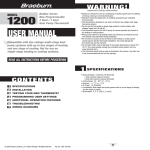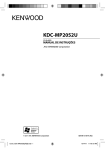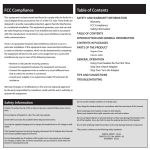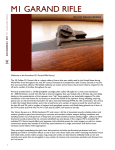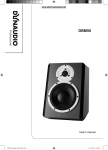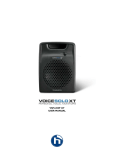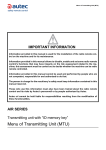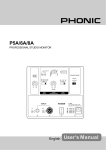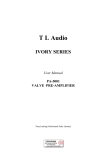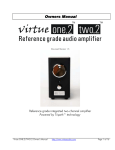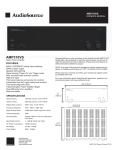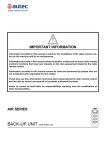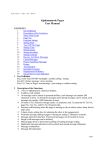Download T-18 Manual.indd
Transcript
USER’S MANUAL T-18 AVIS: CAUTION: FOR CONTINUED PROTECTION AGAINST RISK OF FIRE, REPLACE ONLY WITH SAME TYPE FUSE AND RATING. The lightning flash with arrowhead symbol is intended to alert the user to the presence of uninsulated “dangerous voltage” within the product’s enclosure that may be of sufficient magnitude to constitute a risk of electric shock to persons. The exclamation point symbol is intended to alert the user to the presence of important operating and maintenance (servicing) instructions in the literature accompanying the subwoofer IMPORTANT SAFETY INSTRUCTIONS 1. 2. 3. 4. 5. 6. 7. 8. 9. 10. 11. 12. 13. 14. 15. 16. 17. Read Instructions - All safety and operating instructions should be read before the subwoofer is operated. Retain Instructions - The safety and operating instructions should be retained for future reference. Heed Warnings - Adhere to all warnings on the subwoofer and in the operating instructions. Follow Instructions - All operating and use instructions should be followed. Water and Moisture - The subwoofer should not be used near water. Examples: near a bathtub, kitchen sink, in a wet basement, near a swimming pool or similar areas. Carts and Stands - The subwoofer should only be used with a cart or stand recommended by the manufacturer. When a cart is used, use caution when moving the cart/subwoofer combination to avoid injury from tip-over. Ventilation - The subwoofer should be situated so that its location or position does not interfere with its proper ventilation. Do not place the subwoofer in a cabinet or bookcase that may impede the flow or air through ventilation openings. Heat - The subwoofer should be situated away from heat sources such as radiators, heaters, heat registers, stoves, or any other device that produces heat. Power Sources - The subwoofer should be connected to a power supply only of the type described in the operating instructions or as marked on the subwoofer. Power Cord Protection - Power supply cords should be routed so they are not likely to be walked on or pinched by items placed upon or against them, paying particular attention to cords at plugs, convenience receptacles, and the point at which they exit from the subwoofer. Cleaning - The subwoofer should only be cleaned with a dry cloth. Non-Use Periods & Lightning Storms - The power cord of the subwoofer should be unplugged when left unused for a long period of time or during a lightning storm. Caution - Do not defeat the safety purpose of the polarized or grounding-type plug. A polarized plug has two blades with one wider than the other. A grounding type plug has two blades and a third grounding prong. The wide blade or the third prong are provided for your safety. If the provided plug does not fit into your outlet, consult an electrician for replacement of the obsolete outlet. Object and Liquid Entry - Care should be taken so that objects do not fall and liquids are not spilled onto the subwoofer. Only use attachments/accessories specified by the manufacturer. Damage Requiring Service - The subwofer should be serviced by qualified service personnell when: the power supply cord or plug has been damaged, objects have fallen or liquid has been spilled into the subwoofer, the subwoofer has been exposed to rain, the subwoofer does not appear to operate normally or exhibits a change in performance. Servicing - The user should not attempt to service the subwoofer beyond what is described in this manual or manufacturer supplied instructions. Welcome to the Power Sound Audio family. We are very excited to welcome you to the Power Sound Audio family. We would like to take this time to congratulate you on your purchase of a T-18 subwoofer. We are confident that the Power Sound Audio subwoofer will meet and possibly exceed your expectations. WARNING! To prevent fire or shock hazard, do not expose this equipment to rain or moisture. To avoid electrical shock, do not remove the driver or amplifier from the enclosure. Please read all warnings on the subwoofer’s amplifier. There are no user serviceable parts inside the subwoofer. Please refer all service questions to techsupport@ powersoundaudio.com. Table of Contents Unpacking................................................................6 Placement................................................................7 Installation................................................................9 Warranty.................................................................15 Please read before unpacking your subwoofer. We suggest unpacking your Power Sound Audio subwoofer on a carpeted floor. This will avoid accidental scratches to a hard surface or to the subwoofer as you remove it from the shipping box. Your Power Sound Audio subwoofer may be very heavy. Please find assistance when needed, and be sure to use all proper lifting methods during the unpacking process (and whenever you move the subwoofer). 5 Unpacking Unpacking Process 1. Inspect the shipping box for any damage. If you notice any damage please contact us at [email protected]. 2. Carefully cut the straps that secure the subwoofer to the pallet. 3. Open the top of the shipping box. You will see a box that contains the grills, and two spacers. The manual, RCA-XLR cable adapter, and power cord are located inside one of the spacers. 4. Remove the grills and spacers. 5. With assistance, lift straight up on the shipping box to reveal your subwoofer. 6. With assistance, lift your subwoofer out of the shipping box and place it on a carpeted floor or blanket to prevent damage. 7. Remove the plastic bag. 8. Remove and retain the foam packaging, the plastic covering, and the shipping box. 9. Visually inspect the subwoofer for any damage. If you notice any damage please contact us at support@powersoundaudio. com. 6 Placement Proper placement of your new Power Sound Audio subwoofer is very important. Bass frequencies are non-directional, meaning the human ear cannot locate a properly functioning subwoofer in a typical home theater environment. While there are “rules of thumb” regarding placement options, every room is a little different. Please remember that each time you move the subwoofer to a different location you should recalibrate the bass levels. Corner placement tends to work well, particularly if there are no large openings into the room near the corner. Another popular placement option is “nearfield”. Place the subwoofer as close as possible to the key seating positions. For example, place the subwoofer directly behind the sofa. Every room has its own set of acoustical challenges, so experiment with different placement options as much as time allows. One method that often works well (particularly if the key seating positions are in close proximity to one another) is to place the subwoofer in your key seating position and then walk around the room while a variety of bassy music and movies play through the system. Mark the top 2 or 3 spots where the bass seems to sound best, then try the subwoofer in those spots. If you are using more than one subwoofer, placing them as close as possible (collocate) to one another will give you the maximum clean output capabilities, but separating them may give you smoother overall bass response at your seating positions. Again, experiment as much as time allows and decide which option sounds best to you. 7 Corner placement away from large opening T-18 Nearfield placement T-18 Multiple subwoofer placement Option 1 (collocated) T-18 T-18 T-18 Option 2 T-18 8 Installation Your subwoofer was designed for easy installation in a typical home theater environment. Please read all the installation instructions to properly optimize your subwoofer. WARNING - Always be sure the power is OFF to any audio component before connecting or disconnecting any wires or cables. This includes your receiver, processor, and subwoofer. 9 1 2 3 4 5 6 7 8 10 AMPLIFIER CONNECTIONS AND CONTROLS 1 2 3 4 5 6 7 8 VOLUME CONTROL The VOLUME control is used to adjust the output level of the subwoofer. This control should be set to a similar level as your loudspeakers in order to achieve a properly blended sound stage. Proper calibration procedures should be used to adjust the level of your subwoofer. = minimum gain (no sound) 0 = maximum gain INPUT The subwoofer INPUT consist of a three pole female XLR connector. If your equipment does not have an XLR subwoofer output, please use the included XLR to RCA adapter cable and, if necessary, the RCA barrel connector. Push on the steel latch lock to remove the XLR cable from the amp. MUTE The MUTE button disables all sound from the subwoofer. IN = Mute disabled Out = Mute enabled LOOPING OUTPUT The LOOPING OUTPUT consists of a three pole male XLR connector. This output is typically used to connect another subwoofer to the system. PGM SEL The PGR SEL button allows you to select between two built-in EQ curves. The two EQ curves were designed to optimize the subwoofer’s performance in large to very large rooms. YOU MUST TURN THE POWER OFF BEFORE PRESSING THE PGM SEL BUTTON. IN = Room size < 5000 cubic feet OUT = Room size > 5000 cubic feet POWER SWITCH The POWER SWITCH is a basic on/off rocker switch. ON = Turns on the subwoofer and leaves it on. POWER OUTLET The powerCon AC connector is a locking three conductor AC connector. DO NOT USE THIS OUTLET. PLEASE KEEP THE PLASTIC PLUG INSTALLED. POWER INLET The powerCon AC connector is a locking three conductor AC connector. The connector must be locked into place for power to flow.DO NOT disconnect the powerCon AC CONNECTOR while the POWER SWITCH is in the ON position. 11 CONNECTING YOUR SUBWOOFER WARNING - Always be sure the power is OFF to any audio component before connecting or disconnecting any wires or cables. This includes your receiver, processor, and subwoofer. Connecting your new subwoofer is relatively easy as long as you are using a modern DD/DTS 5.1 or 7.1 receiver or processor. Simply connect the subwoofer preout (RCA) on the rear panel of your receiver/processor to the INPUT (XLR) on the subwoofer amplifier using the included adapter cable. If you have a two channel stereo system please contact Power Sound Audio to discuss the best option to connect your new subwoofer. RECEIVER/PROCESSOR PRE OUT FRONT SIDE REAR CENTER SUBWOOFER 12 SETUP PROCEDURES RECEIVER/PROCESSOR BASS MANAGEMENT OPTIONS Once the subwoofer is connected to your receiver or processor you should enter the “set up” menu and set all of your speakers to “small”. If there are options for the crossover frequency e.g., 40hz, 60hz, 80hz, 100hz, start with 80hz. This will reroute all of the bass from your main speakers to the subwoofer. TURNING THE SUBWOOFER ON FOR THE FIRST TIME Please set the VOLUME to minimum, then press the power selector switch to ON. The PWR LED should now glow green. While listening to bass heavy material, slowly increase the VOLUME control until the bass levels sound natural to you. This will give you a starting point for the VOLUME control. Typical setting is between -16dB to -10dB. VOLUME SETTING Setting bass levels in your home system is usually accomplished in one of three ways: automatically by your receiver or processor, manually with your receiver or processors built-in test tones (or a test disc) and an SPL meter, or by ear. Auto-level adjustment Your receiver or processor will automatically adjust the output level of your subwoofer. You may need to adjust the VOLUME on the subwoofer if it is too low or too high for the receiver or processor to correct. Please see your receiver or processor’s manual for instructions on automatically setting the VOLUME on your subwoofer. Setting bass levels using a SPL meter This method tends to result in the most accurate bass volume. Simply hold the SPL meter about ear high while sitting in your key seating position. Activate the receiver or processor’s calibration test tones and watch the meter as the tones move from speaker to speaker. Unless your receiver or processor’s manual specifies otherwise, set all speakers, including the subwoofer, to the same output level. Setting bass levels by “ear” The best way to adjust the VOLUME on your subwoofer is to use familiar bass heavy material. Use the receiver or processor’s remote control to manually adjust the bass levels to your preference. While it is human nature to want to really “HEAR” the bass from your brand new subwoofer, setting the levels to a more natural level will sound best in the long run. 13 SETUP PROCEDURES LED INDICATORS SIGNAL - Illuminates (flashes) during normal operation when the amplifier receives a signal. This LED is will display even if the subwoofer is muted or if the VOLUME is at the minimum setting. PROT - Illuminates with a specific number of flashes when one of the following conditions are met. 120VAC Model 1 Flash = Ground opened or phase/neutral reversed. Flashes ten times, then stops. Amp does not shut down. 2 Flashes = GFI trip 3 Flashes = Overheating 4 Flashes = Interal fault or DC protection 5 Flashes = Power line voltage is too high 6 Flashes = Power line voltage is too low 7 Flashes = Over current (current limiting too often) 8 Flashes = Over clipping (clipping too often) 230VAC Model (Long flash - Short flash) 1-0 = Earth open. Flashes ten times, then stops. 1-1 = Line and neutral reversed. Flashes ten times, then stops. 1-2 = GND not connected in 230V mode. Flashes ten times, then stops. 2-0 = GFI trip. Amp shuts down. Power cycle to restore. 3-0 = Overheat shutdown. Restarts when temp falls. 3-3 = Thermal limiter acting. Amp still runs. 3-4 = NTC fault. Amp shuts off. Restarts. Putting in switch for warn only. 4-1 = Fault from gate PCB while amp was working ok. May reset with power cycle. 4-2 = Fault from PFC. May reset with power cycle. 4-3 = GFI malfunction. Not tripped, but not working. 4-4 = +12V GFI overvoltage. 4-5 = Fault from gate PCB did not clear at softstart. 4-6 = Clipping from gate PCB did not set at softstart. 4-7 = Brownout during softstart. Check for short. 4-8 = Unable to start amplifier. 5-0 = Overvoltage. Amp turns off or won’t start. 6-0 = Undervoltage. Amp turns off or won’t start. 6-6 = Line limiter acting. Amp still runs. CLIP - Illuminates when the amplifier approaches its maximum output capabilities. PWR - Illuminates when the amplifier is turned on a working correctly. If the LED does not illuminate, check the power connector and make sure it is locked in place. 14 PUSH BUTTON SWITCHES MUTE - Disables all sound from the subwoofer. This button is used mainly during setup or troubleshooting. In = Mute disabled Out = Mute enabled PRG SEL - The PGR SEL button allows you to select between two built-in EQ curves. The two EQ curves were designed to optimize the subwoofer’s performance in large to very large rooms. YOU MUST TURN THE POWER OFF BEFORE PRESSING THE PGM SEL BUTTON. IN = Room size < 5000 cubic feet (Typical setting) OUT = Room size > 5000 cubic feet Warranty Power Sound Audio warrants its products to be free from original manufacturing defects in materials and workmanship for a period of 5 years from the original date of purchase. The warranty applies to the product and not the end user. If the product is transferred to another party, we ask that the new owner contact us with their information so we can update our records. Power Sound Audio will repair or replace any defective part with a new or refurbished part, free of charge, during the warranty period. If the product under warranty has been discontinued and cannot be repaired, Power Sound Audio will replace the original product with a product of equal or greater value, either new or refurbished. This warranty does not cover cosmetic damage, damage from improper use, accidents, abuse, misuse, acts of God, or unauthorized modifications. Please contact us if you need warranty service. Warranty Department [email protected] 15















